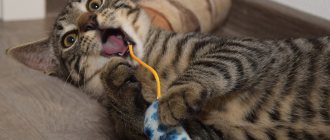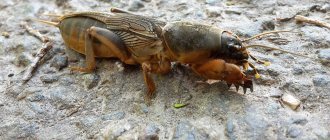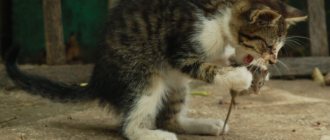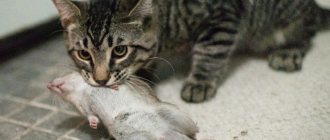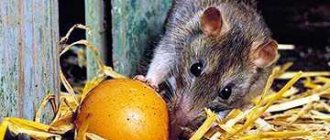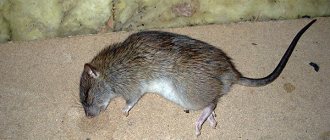For most of us, cats are the embodiment of home comfort, tranquility and laziness. Few people would think that these charming couch potatoes can bring tangible benefits. And yet it is so. Today we will talk about rat-catching cats that can clean the house and surrounding area from mice and rats
Despite the fact that all cats are predators, not everyone can become a good rat catcher. The rodent hunter must have strong bones, well-developed muscles, long, dexterous paws and (optional) striped or tri-colored coloring that will provide good camouflage.
Gender matters too. Ratcatching cats are very rare; cats usually hunt rodents. They are driven by maternal instinct, or more precisely, by the need to feed and protect their offspring.
If a cat actively catches mice and rats, she will teach her cubs to do the same. Therefore, they should not be separated from their mother earlier than 4-5 months after birth.
Since domestic cats have been living with humans for hundreds of years, they have no urgent need to get their own food. Therefore, in many ornamental varieties, hunting instincts have been lost. On the other hand, there are many breeds that were and remain excellent predators and in which the hunter gene is highly developed.
European shorthair cat
Small smooth-haired animals of gray striped, spotted or marbled color are considered to be outbred. But these “plebeians” caught rats and mice back in Ancient Rome. The European Shorthair cat is a strong, agile and intelligent animal. She loves and knows how to hunt, and at the same time has good contact with people. However, if you pick up a mongrel kitten on the street, you shouldn’t hope that it will start exterminating rats left and right. As a rule, private breeders or nurseries are engaged in breeding really high-quality rat-catcher cats, and often there is a queue for offspring almost a year in advance. If you want such a cat, look for trusted breeders with recommendations, but remember that it takes 4-5 months for a mother to teach her cub predator skills, so you should give preference to older kittens.
Ratcatcher cats can catch rats, mice, snakes and moles equally well, but they will also calmly deal with domestic animals - ducklings or chickens. Therefore, it is important to raise the animal correctly from the very beginning.
Relationship with the owner
A true Briton is smug and self-sufficient, and views his owners as breadwinners. It is not without reason that this breed is considered suitable for business people. They don't like to sit on their hands and can't stand noisy companies at all.
After a long day of work, the pet will greet the person reverently and tenderly, and will rub against the legs. They don’t like it when the owner stays late somewhere and doesn’t come home from work on time.
If there is a child in the family, you should not have a Briton for his entertainment. Representatives of this breed are very patient with children, but they will not allow themselves to be made into toys. They will hide and run away.
It is very rare for a straight-eared Briton to be “tame.” He doesn't often ask to be held and petted. However, when he needs to climb onto his owner’s lap, he will follow along until he achieves his goal.
Siamese cat
Another hunting breed with a long history. The first mentions of blue-eyed beauties date back to the 13th century. They come from the kingdom of Siam. Smooth-haired, lean animals are distinguished by excellent reactions and the ability to show aggression when necessary. Siamese get along well with people, but have a rather independent disposition. Their small size does not allow these cats to hunt rats effectively, but they do an excellent job with mice. The instinct is transmitted at the genetic level and strengthened in kittens by their mother.
The rat is a fairly large rodent, and therefore the hunter should not be small. It is necessary that she has well-developed muscles, skeleton and jaws, and a stable psyche. If she hides or runs away from any loud sound, the cat will no longer be able to become a good rat catcher.
Character and behavior of lop-eared animals
The Scotsman is a purebred cat that is distinguished by its kind disposition. Distinctive behavioral traits:
- communication skills and sociability;
- love for children;
- gaiety;
- easy to educate with the right and friendly approach;
- actually cannot be trained;
- playful;
- not mischievous;
- they quickly forget bad things and do not take revenge.
Scottish Folds are an ideal option when there are other animals and children in the house. Such kittens are real aristocrats with their mannerisms and waywardness. Their restiveness and capriciousness are often observed. If the Scots want something, they will definitely achieve it. An adventurous breed with a curiosity for the unknown. When new people appear on their territory, Scottish cats are not very friendly, but then they begin to communicate. Scots love to play, but are not particularly happy with cuddling and cuddling.
Maine Coon
These luxurious, large (weighing up to 15 kg) cats come from America, more precisely the state of Maine. They were specially bred to exterminate mice and rats on farms and ships. Despite their impressive size, Maine Coons are agile and agile. Large ears provide them with excellent hearing, and strong paws provide them with a good grip.
Thick, long hair allows the Maine Coon to live in harsh climates. But it also creates problems for the owners. The fact is that these cats need to be brushed regularly. If you leave the animal to its own devices, the magnificent fur will quickly become tangled and no longer protect against the cold.
The disadvantages of Maine Coons include gluttony (which should not be surprising, given their size) and independent character. These natural hunters are not particularly interested in constant human contact. They shy away from petting that they consider inappropriate, and if the owner is too intrusive, they can get angry and bite.
Ratcatcher cats need regular, long walks to stay in good physical shape.
The best mousecatcher breeds
Among the huge number of breeds of representatives of the cat family, there are several undisputed leaders, whose hunting habits are noted by felinologists and professional breeders.
Maine Coon
Maine Coons are kept on large farmlands because these cats are excellent at protecting their property and are not afraid to hunt huge rats. Despite their large dimensions, the animals are distinguished by their mobility and speed. Resistance to adverse weather conditions and the desire to catch prey allow them to track prey for hours. For the Maine Coon, hunting is a game of chance.
Russian blue
The graceful appearance and relatively small body size cause many breeders to doubt the hunting capabilities of representatives of the Russian Blue breed. However, excellent endurance, the ability to move silently and lightning-fast reactions allow these animals to show incredible hunting qualities. Hunting small and large rodents can be compared to real art.
Siberian
The Siberian cat is one of the best rat catchers. Thanks to the pubescent pads and the presence of hair between the toes, which serve as sound insulators, the hunter watches the prey completely silently and unnoticed. Lightning-fast reactions, high speed and long standing jumps leave rodents no chance of survival.
Representatives of the Siberian breed rarely live in houses; they like a free life. Accordingly, they spend most of their time on the street, tracking down potential victims of a new hunt.
Kurilian Bobtail
It is believed that cats of the Kurilian Bobtail breed have a “dog” temperament. A pet follows its owner everywhere, protecting and protecting him. The main danger to humans, as these amazing animals suggest, are mice, rats and other rodents. The Kurilian Bobtail, wanting to protect its owner, directs all its strength and hunting instincts to tracking down and catching small parasites.
The main character qualities include incredible endurance, endurance, determination and amazing courage. Long and powerful hind legs allow them to develop enormous speed and make long standing jumps.
Cymric
Agile paws and tenacious claws are the main weapons of the Cymric breed. For good health and physical development, your pet needs long walks outside. Long walks make it possible to track rodents, watch them for a long time and at one moment catch them in a swift jump.
British Shorthair
The British Shorthair is an aristocratic breed. But few people know that the British Shorthair is one of the Top 6 rat-catching cats. Excellent inclinations and the instinct of a hunter drive the animal. If the cat marks the target, the rodent has no chance of getting out of this fight alive.
The British Shorthair does not hunt large rodents, preferring mice and young rats. The reason for this is the relatively small size and weight of the body.
Russian blue cat
This is a real aristocrat among rat catchers. Russian blue cats were kept at court by many royals, for example, Peter I and Catherine II. Centuries later, these graceful, smooth-haired animals remain excellent hunters. They can handle not only mice, but also rats weighing up to 0.5 kg!
It is worth noting that Russian Blue cats do not get along well with representatives of other breeds, but get along well with their own. Like many other predators, they are not particularly susceptible to affection, but at the same time they treat people with sympathy and rarely show aggression.
Please note - a lazy, barely mobile cat cannot become a good rat catcher.
The meaning of appearance and the main characteristics of a hunter
At first glance, it is very difficult to determine how good a cat is at catching mice. But experts have identified several signs that indicate a successful hunter:
- muscular body;
- strong paws;
- powerful jaws;
- the outline of the skull resembles a triangle;
- ears are high, with tassels;
- bushy mustache;
- variegated coloring;
- short hair.
In addition, the cat must be active and have a good appetite. It is clear that it is almost impossible to detect the totality of all signs in one cat. But it is precisely these qualities that you should pay attention to when choosing a kitten that will catch mice.
Kurilian Bobtail
Bobtails are quite large animals, capable of rivaling Maine Coons in size. The weight of a cat can reach 10 kg, and that of a cat - 6 kg. The homeland of this breed is the Kuril Islands. Difficult living conditions raised them to be brave and strong hunters. They have a short tail and strong legs, providing excellent jumping ability. Bobtails cope with both mice and large rats.
Among other breeds, the bobtail is distinguished by its sociability and easy-going character. They readily make contact with humans, are easy to train and get along well with other animals, including large dogs. This makes them similar to another “tailless” cat - the Manx cat
, which also has a friendly disposition combined with excellent hunting skills.
Kurilian Bobtail
Manx cat
Can neutered cats catch mice?
It is believed that spaying and castration does not affect the hunting skill of a pet. In practice, things are different. Such operations often have a negative impact on the animal’s behavior and physiological state. If you castrate a cat, the animal becomes lazy and passive, sleeps for a long time, not interested in what is happening around. Also, after castration, cats gain excess weight, which interferes with successful hunting. To ensure that the rat catcher does not lose his skills, after the operation the animal must be fed with suitable dietary food and stimulated to be active.
Cymric
These are medium-sized cats, also without a tail. They have long, tenacious legs that allow them to catch up with prey and grab it with a death grip. They have a strong skeleton with athletically developed muscles. Cymrics are sociable and active, and it is very important for them to spend a lot of time outdoors. It is not worth keeping such a mobile animal in an apartment - during games it will destroy everything around. Experienced breeders recommend keeping these cats in country houses.
The role of living conditions
Living not in a private house, but in an apartment, a cat often catches mice for entertainment, not profit. Yard cats, or those who live in a private house, are better accustomed to hunting for food. These cats are more familiar with nature and the sight of a mouse will not cause them any confusion. Although, it is worth noting that instincts developed over centuries are not so easy to suppress, and over time, under certain conditions, even very domestic cats can become predators.
Still from the cartoon “Cinderella 2: Dreams Come True”
Siberian cat
Siberian cat
This breed appeared in Siberia several centuries ago. Harsh winters forced these large cats, weighing up to 9 kg, to grow thick, long hair and learn to get enough food for themselves to survive. The Siberian cat is an excellent hunter, killing both mice and rats. She easily and quickly overtakes her prey, and her long claws do not allow her to escape. Cats are patient and can stalk their prey for hours, waiting for the best moment. The animal loves to spend time outdoors, so it is better in the house than in the apartment. It is not aggressive, but it treats people rather indifferently. Siberian is a cat that walks on its own.
Tailed liberators of Leningrad
When all the cats in the besieged city were eaten in 1943, rats began to multiply at a catastrophic rate. They ran through the streets like a businessman in search of corpses, climbed into apartments, destroyed furniture and the last supplies.
The rodents were shot by special brigades and crushed by tanks, but the “rat troops” did not retreat. The city was saved by rat-catching cats of Russian and Siberian breeds. They were brought in trains from all over the country after the blockade was broken.
Today, two sculptures remind us of the four-legged liberators. One depicts the cat Vasilisa standing on the ledge, the second depicts the cat Elisha sitting opposite. St. Petersburg residents believe that whoever throws a coin on a cat pedestal will be lucky.
British shorthair cat
British cats combine developed hunting instincts, friendliness and calmness. The weight of the animal rarely exceeds 4 kg, so it is difficult for it to fight with a rat. But the British do an excellent job with mice. And they often bring them home as a gift to the owner. You shouldn’t be angry about this, because this is how the cat shows care. From her point of view, a person is a helpless creature, unable to provide food for himself.
Of course, choosing a kitten from this list does not mean that an excellent rat catcher will appear in the house. Heredity is of great importance. Let's repeat - if a mother cat is a good hunter, most likely her kittens will be the same. A clue as to whether a kitten will catch mice and rats can be its behavior. If during play he grabs the “prey” with his teeth, and not just grabs it with his paws, most likely he has a tendency to hunt.
You need to play active games with the growing animal, let it go for walks around the area as often as possible and reward it for every prey, even if it is not a mouse or rat, but an insect. At the same time, it is impossible to starve an animal by pushing it to obtain food on its own. The cat will look for food, scouring garbage dumps, or even leave altogether in search of a better life. You need to feed the rat catcher 4-6 times a day, in small portions.
It is extremely important to regularly give your cat all necessary vaccinations, and first of all - against rabies. After all, during a hunt, a pet can pick up a dangerous infection from a rodent. And of course, if traces of scratches or bites are found on your pet’s body, you should immediately contact a veterinarian
By what signs can you recognize a rat catcher?
A mousetrap cat is not a breed, but a rare skill that a pet develops due to the conditions of its keeping and upbringing. The best hunters are considered to be mongrel cats, who have had to hunt mice for food since childhood.
Street animals are not spoiled by the attention and care of the owner, so the hunting instinct develops and remains for the maximum period
The following signs will help you recognize a future rat catcher in a kitten:
- if one of the parents is good at catching mice, by four months the skill will be transferred to the kitten;
- female. Cats catch mice better than cats, which is associated with increased activity and fearlessness. To feed her offspring, the mother cat will get food in any way, so her hunting instinct is heightened;
- head shape. Animals with a triangular oriental skull shape have greater potential for catching rats;
- activity in the game. If a kitten runs after ribbons, toy mice and catches them with his teeth, he will make a good hunter;
- physiological characteristics. The pet must be well built, have developed muscles, strong bones;
- high ears with tassels. Allow the pet to track rustles and squeaks, which increases the likelihood of finding a target;
- color feature. It is believed that the best hunters are tri-colored, tortoiseshell, and motley cats.
The listed signs increase the likelihood of a successful hunt. But the development of the skill depends on the conditions of detention and upbringing. If you keep your pet in an apartment and give it food when called, the hunting instinct will “die out.”
Nutritional Features
Domestic cats often catch mice for fun, and successful hunting requires a lot of strength. You can feed your pet both natural food and commercial food. The main thing is that the food suits him, suppresses the feeling of hunger (but does not oversaturate him), provides the body with vitamins and minerals and strengthens the immune system.
Nutrition is important for successful hunting
